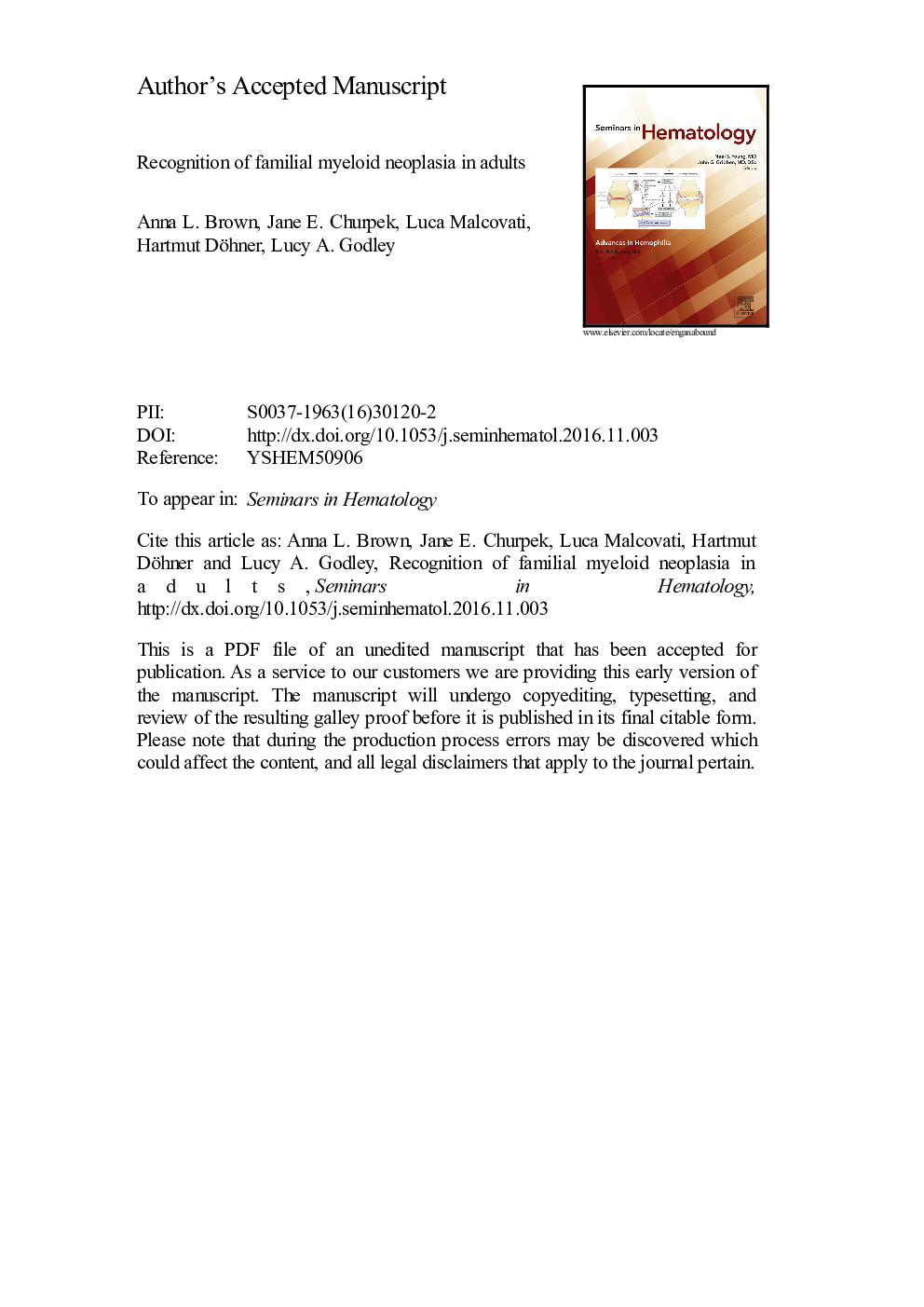| کد مقاله | کد نشریه | سال انتشار | مقاله انگلیسی | نسخه تمام متن |
|---|---|---|---|---|
| 5664415 | 1407705 | 2017 | 38 صفحه PDF | دانلود رایگان |
عنوان انگلیسی مقاله ISI
Recognition of familial myeloid neoplasia in adults
ترجمه فارسی عنوان
تشخیص نئوپلاسی میلوئیدی خانوادگی در بزرگسالان
دانلود مقاله + سفارش ترجمه
دانلود مقاله ISI انگلیسی
رایگان برای ایرانیان
کلمات کلیدی
جهش های ژرمینال، استعداد ذاتی، بدخیمی های فامیلی خانوادگی،
ترجمه چکیده
سندرم های بدخیم هماتولوژیک ارثی به طور فزاینده ای به عنوان علت سرطان های خونگرم بالغ شناخته شده اند و ظهور توالی نسل بعدی کشف سندرم های جدید بر اساس خوشه بندی انبوه این بیماری ها در خانواده های خاص را تسریع کرده است. در حال حاضر طرح های طبقه بندی شده برای بدخیمی های میلوئیدی در حال حاضر شامل توصیه هایی برای گرفتن سابقه خانوادگی در همه بیماران مبتلا به بدخیم های خونریزی و مشاوره ژنتیکی و آزمایش افراد و خانواده های مناسب می باشد. بنابراین، اکنون بیشتر از همیشه، پزشکان و آسیب شناسان باید یک شاخص بالقوه سوء ظن را داشته باشند و با جنبه های سابقه شخصی یا خانوادگی بیمار آشنا باشند که باید سوء ظن در مورد این سندرم ها و نیز گزینه های آزمایش بالینی را مطرح کند. هر گاه امکان پذیر است، افراد باید با سیستم های تایید شده بالینی آزمایش شوند که بتواند هر دو جهش نقطه و بازسازی ژنومی را شناسایی کند که عملکرد ژن را مختل کند، بنابراین نتایج بلافاصله قابل اجرا خواهند بود. افراد و خانواده هایی که جهش در جهات ژن معکوس ژرمین شناخته شده را منفی می دانند به عنوان منابع مهم کشف سندرم های حساس به ارثی جدید به حساب می آیند.
موضوعات مرتبط
علوم پزشکی و سلامت
پزشکی و دندانپزشکی
هماتولوژی
چکیده انگلیسی
Hereditary hematologic malignancy (HM) syndromes are increasingly recognized as causative of adult hematopoietic cancers, and the advent of next-generation sequencing has accelerated the discovery of new syndromes based on dense clustering of these diseases in particular families. Updated classifications schemes for myeloid malignancies will now include recommendations for taking a family history on all patients diagnosed with hematopoietic malignancies and for genetic counseling and testing of appropriate individuals and families. Therefore, now more than ever, clinicians and pathologists will need to have a high index of suspicion and be familiar with the aspects of a patient's personal or family history that should raise suspicion regarding these syndromes as well as the options for clinical testing. Whenever possible, individuals should be tested with certified, clinical platforms that can detect both point mutations and genomic rearrangements that disrupt gene function so that results are immediately actionable. Individuals and families who test negative for mutations in the known germline predisposition genes serve as important sources of discovery for new inherited susceptibility syndromes.
ناشر
Database: Elsevier - ScienceDirect (ساینس دایرکت)
Journal: Seminars in Hematology - Volume 54, Issue 2, April 2017, Pages 60-68
Journal: Seminars in Hematology - Volume 54, Issue 2, April 2017, Pages 60-68
نویسندگان
Anna L. Brown, Jane E. Churpek, Luca Malcovati, Hartmut Döhner, Lucy A. Godley,
